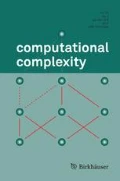Abstract
We prove a lower bound of the formN Ω(1) on the degree of polynomials in a Nullstellensatz refutation of theCount q polynomials over ℤ m , whereq is a prime not dividingm. In addition, we give an explicit construction of a degreeN Ω(1) design for theCount q principle over ℤ m . As a corollary, using Beameet al. (1994) we obtain a lower bound of the form 2NΩ(1) for the number of formulas in a constant-depth Frege proof of the modular counting principleCount N q from instances of the counting principleCount M m .
We discuss the polynomial calculus proof system and give a method of converting tree-like polynomial calculus derivations into low degree Nullstellensatz derivations.
Further we shwo that a lower bound for proofs in a bounded depth Frege system in the language with the modular counting connectiveMOD p follows from a lower bound on the degree of Nullstellensatz proofs with a constant number of levels of extension axioms, where the extension axioms comprise a formalization of the approximation method of Razborov (1987) and Smolensky (1987) (in fact, these two proof systems are basically equivalent).
Similar content being viewed by others
References
M. Ajtai, The complexity of the pigeonhole principle. InProceedings of the 29th IEEE Symposium on Foundations of Computer Science, 1988, 346–355.
M. Ajtai, Parity and the pigeonhole principle. InFeasible Mathematics, ed.S. R. Buss and P. J. Scott, Birkhäuser, 1990, 1–24.
M. Ajtai, The independence of the modulop counting principle. InProceedings of the 26th ACM STOC, 1994, 402–411.
P. Beame, S. Cook, J. Edmonds, R. Impagliazzo, and T. Pitassi, The relative complexity ofNP search problems. InProceedings of the 27th ACM STOC, 1995, 303–314.
P. Beame, R. Impagliazzo, J. Krajíček, T. Pitassi, and P. Pudlák, Lower bounds on Hilbert's Nullstellensatz and propositional proofs. InProceedings of the 35th IEEE FOCS, 1994, 794–806. Journal version to appear inProc. of the London Math. Soc.
P. Beame and T. Pitassi, Exponential separation between the matching principles and the pigeonhole principle. Submitted toAnnals of Pure and Applied Logic, 1993.
P. Beame and S. Riis, More on the relative strength of counting principles. To appear inProceedings of the DIMACS workshop on Feasible Arithmetic and Complexity of Proofs, 1996.
S. Bellantoni, T. Pitassi, andA. Urquhart, Approximation of small depth Frege proofs.SIAM Journal on Computing 21 (6) (1992), 1161–1179.
M. Bonet, T. Pitassi, and R. Raz, Lower bounds for cutting planes proofs with small coefficients. InProceedings of the 27th ACM STOC, 1995, 575–584.
Samuel R. Buss, A new exposition of the design for the housesitting principle. Manuscript, 1995a.
Samuel R. Buss, Some remarks on lengths of propositional proofs.Archive for Mathematical Logic 34 (1995b), 377–394.
V. Chvátal andE. Szemerédi, Many hard examples for resolution.Journal of the ACM 35(4) (1988), 759–768.
M. Clegg, J. Edmonds, and R. Impagliazzo, Using the Groebner basis algorithm to find proofs of unsatisfiability. InProceedings of the 28th ACM STOC, 1996, 174–183.
S. A. Cook andA. R. Reckhow, The relative efficiency of propositional proof systems.Journal of Symbolic Logic 44(1) (1979), 36–50.
A. Haken, The intractability of resolution.Theoretical Computer Science 39 (1985), 297–308.
Johan Håstad, Almost optimal lower bounds for small depth circuits. InRandomness and Computation (Advances in Computing Research, Vol. 5), ed.S. Micali, 143–170. JAI Press, 1989.
R. Impagliazzo, The sequential ideal generation proof system. Unpublished note, 1995.
J. Krajíček, Lower bounds to the size of constant-depth propositional proofs.Journal of Symbolic Logic 59(1) (1994a), 73–86.
J. Krajíček, Interpolation theorems, lower bounds for proof systems and independence results for bounded arithmetic. To appear inJournal of Symbolic Logic, 1994b.
J. Krajíček,Bounded arithmetic, propositional logic and complexity theory. Encyclopedia of Mathematics and Its Applications, Vol.60, Cambridge University Press, 1995.
J. Krajíček, A fundamental problem of mathematical logic.Annals of the Kurt Gödel Society, Collegium Logicum, Vol.2, Springer-Verlag, 1996, 56–64.
J. Krajíček, On methods for proving lower bounds in propositional logic. InLogic and Scientific Methods, eds. M. L. Dalla Chiara et al., (Vol. 1 of Proc. of the Tenth International Congress of Logic, Methodology and Philosophy of Science, Florence, August 19–25, 1995), Synthese Library, Vol.259, Kluwer Academic Publ., Dordrecht, 1997, 69–83.
J. Krajíček, P. Pudlák, andA. R. Woods, Exponential lower bounds to the size of bounded depth Frege proofs of the pigeonhole principle.Random Structures and Algorithms 7(1) (1995), 15–39.
J. B. Paris, A. J. Wilkie, andA. R. Woods, Provability of the pigeonhole principle and the existence of infinitely many primes.Journal of Symbolic Logic 53(4) (1988), 1235–1244.
T. Pitassi, Algebraic Propositional Proof Systems. To appear in the proceedings volume of the DIMACS workshop onFinite Models and Descriptive Complexity, held January 14–17, 1996.
T. Pitassi, P. Beame, andR. Impagliazzo, Exponential lower bounds for the pigeonhole principle.computational complexity 3 (1993), 97–140.
P. Pudlák, The lengths of proofs. To appear inHandbook of Proof Theory, 1995a.
P. Pudlák, Lower bounds for resolution and cutting planes proofs and monotone computations. To appear inJournal of Symbolic Logic, 1995b.
A. A. Razborov, On the method of approximation. InProceedings of the 21st ACM Symposium on Theory of Computing, 1989, 167–176.
A. Razborov, Lower bounds for the polynomial calculus. To appear incomputational complexity 7 (1998).
R. A. Reckhow, On the lengths of proofs in the propositional calculus. Technical Report 87, University of Toronto, 1976.
S. Riis,Independence in Bounded Arithmetic. PhD thesis, Oxford University, 1993.
S. Riis, Count(q) does not imply Count(p). Technical Report RS-94-21, Basic Research in Computer Science Center, Aarhus, Denmark, 1994.
R. Smolensky, Algebraic methods in the theory of lower bounds for Boolean circuit complexity. InProceedings of the 19th ACM Symposium on Theory of Computing, 1987, 77–82.
A. Urquhart, Hard examples for resolution.Journal of the ACM 34(1) (1987), 209–219.
A. Urquhart, The complexity of propositional proofs.Bulletin of Symbolic Logic 1 (1995), 425–467.
A. Wigderson, The fusion method for lower bounds in circuit complexity. InCombinatorics, Paul Erdős is Eighty (Vol. 1) (1993), 453–468.
Author information
Authors and Affiliations
Rights and permissions
About this article
Cite this article
Buss, S., Impagliazzo, R., Krajíček, J. et al. Proof complexity in algebraic systems and bounded depth Frege systems with modular counting. Comput Complexity 6, 256–298 (1996). https://doi.org/10.1007/BF01294258
Received:
Issue Date:
DOI: https://doi.org/10.1007/BF01294258




